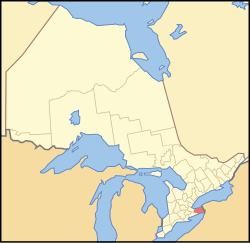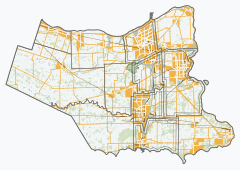Regional Municipality of Niagara
The Regional Municipality of Niagara, also colloquially known as the Niagara Region or Region of Niagara, is a regional municipality comprising twelve municipalities of Southern Ontario, Canada. The regional seat is in Thorold. It is the southern end of the Golden Horseshoe, the largest megalopolis in Canada.
Niagara Region | |
|---|---|
| Regional Municipality of Niagara | |
| Motto(s): Unity, Responsibility, Loyalty | |
 Location of Niagara within Ontario | |
| Coordinates: 43°02′33″N 79°18′02″W / 43.04250°N 79.30056°W[1] | |
| Country | Canada |
| Province | Ontario |
| Formed | 1970 (from Welland and Lincoln Counties) |
| Seat | Thorold |
| Government | |
| • Chair | Jim Bradley |
| • Governing body | Niagara Regional Council |
| • MPs | Dean Allison, Chris Bittle, Vance Badawey, Tony Baldinelli |
| • MPPs | Jeff Burch, Wayne Gates, Sam Oosterhoff, Jennie Stevens |
| Area | |
| • Land | 1,852.82 km2 (715.38 sq mi) |
| Population (2021)[2] | |
• Total | 477,941 |
| • Density | 258.0/km2 (668/sq mi) |
| Gross Metropolitan Product | |
| • St. Catharines – Niagara CMA | CA$17.4 billion (2020)[3] |
| Time zone | UTC−05:00 (EST) |
| • Summer (DST) | UTC−04:00 (EDT) |
| Website | www |
The region occupies most of the Niagara Peninsula. Its eastern boundary is the Niagara River, which is also the border with the US state of New York. It is bounded on the north by Lake Ontario and on the south by Lake Erie.
Unique natural landscapes make the Niagara Region an important centre for agriculture and tourism in Canada. The most important agricultural enterprise in Niagara is viticulture, or winemaking. The Niagara Wine Route, which connects visitors to dozens of wineries, is a growing tourism draw while the internationally renowned Niagara Falls is one of Canada's major tourist attractions. Along with Shaw Festival, held annually in Niagara-on-the-Lake, and the Welland Canal, the Regional Municipality of Niagara receives up to 12 million visitors each year.
Niagara Region is situated on treaty land. This land has a rich history of First Nations such as the Neutral, the Haudenosaunee, and the Anishinaabe, including the Mississaugas of the Credit First Nation.[4] There are many First Nations, Métis, and Inuit people from across Turtle Island that continue to live and work in Niagara today.
Administrative divisions
edit| Name | Type | Sub-region | Population |
|---|---|---|---|
| Niagara Falls | City | Welland | 94,415 |
| Port Colborne | City | Welland | 20,033 |
| St. Catharines | City | Lincoln | 136,803 |
| Thorold | City | Welland | 23,816 |
| Welland | City | Welland | 55,750 |
| Fort Erie | Town | Welland | 32,901 |
| Grimsby | Town | Lincoln | 28,883 |
| Lincoln | Town | Lincoln | 25,719 |
| Niagara-on-the-Lake | Town | Lincoln | 19,088 |
| Pelham | Town | Welland | 18,192 |
| Wainfleet | Township | Welland | 6,887 |
| West Lincoln | Township | Lincoln | 15,454 |
Demographics
editAs a census division in the 2021 Census of Population conducted by Statistics Canada, the Regional Municipality of Niagara had a population of 477,941 living in 195,914 of its 207,926 total private dwellings, a change of 6.7% from its 2016 population of 447,888. With a land area of 1,852.82 km2 (715.38 sq mi), it had a population density of 258.0/km2 (668.1/sq mi) in 2021.[2]
| 2021 | 2016 | 2011 | |
|---|---|---|---|
| Population | 477,941 (+6.7% from 2016) | 447,888 (+3.8% from 2011) | 431,346 (+0.9% from 2006) |
| Land area | 1,852.82 km2 (715.38 sq mi) | 1,854.23 km2 (715.92 sq mi) | 1,854.25 km2 (715.93 sq mi) |
| Population density | 258.0/km2 (668/sq mi) | 241.5/km2 (625/sq mi) | 232.6/km2 (602/sq mi) |
| Median age | 46.0 (M: 44.0, F: 47.2) | 45.7 (M: 44.4, F: 46.9) | |
| Private dwellings | 207,926 (total) 195,914 (occupied) | 196,241 (total) | 188,877 (total) |
| Median household income | $79,000 | $65,086 |
|
| |||||||||||||||||||||||||||||||||||||||
| Source: Statistics Canada[2][10][11] | ||||||||||||||||||||||||||||||||||||||||
Religion
editReligious profile (2021):[2]
Ethnicity
edit| Panethnic group |
2021[2] | 2016[12] | 2011[10] | 2006[13] | 2001[11] | |||||||||
|---|---|---|---|---|---|---|---|---|---|---|---|---|---|---|
| Pop. | % | Pop. | % | Pop. | % | Pop. | % | Pop. | % | |||||
| European[a] | 393,100 | 83.74% | 387,095 | 88.35% | 385,785 | 91.24% | 388,415 | 92.1% | 382,050 | 94.43% | ||||
| Indigenous | 13,960 | 2.97% | 12,250 | 2.8% | 9,055 | 2.14% | 6,930 | 1.64% | 5,185 | 1.28% | ||||
| South Asian | 13,845 | 2.95% | 6,170 | 1.41% | 3,450 | 0.82% | 3,805 | 0.9% | 2,585 | 0.64% | ||||
| African | 13,305 | 2.83% | 7,970 | 1.82% | 6,485 | 1.53% | 5,210 | 1.24% | 3,960 | 0.98% | ||||
| Southeast Asian[b] | 9,715 | 2.07% | 5,950 | 1.36% | 4,525 | 1.07% | 4,310 | 1.02% | 2,580 | 0.64% | ||||
| East Asian[c] | 9,365 | 1.99% | 8,230 | 1.88% | 5,835 | 1.38% | 5,570 | 1.32% | 4,370 | 1.08% | ||||
| Latin American | 6,975 | 1.49% | 4,620 | 1.05% | 3,895 | 0.92% | 4,260 | 1.01% | 1,570 | 0.39% | ||||
| Middle Eastern[d] | 4,610 | 0.98% | 3,430 | 0.78% | 2,230 | 0.53% | 2,120 | 0.5% | 1,485 | 0.37% | ||||
| Other[e] | 4,575 | 0.97% | 2,455 | 0.56% | 1,550 | 0.37% | 1,130 | 0.27% | 810 | 0.2% | ||||
| Total responses | 469,455 | 98.22% | 438,160 | 97.83% | 422,805 | 98.02% | 421,750 | 98.67% | 404,590 | 98.54% | ||||
| Total population | 477,941 | 100% | 447,888 | 100% | 431,346 | 100% | 427,421 | 100% | 410,574 | 100% | ||||
| Note: Totals greater than 100% due to multiple origin responses | ||||||||||||||
Human trafficking
editThe area has a higher concentration of human trafficking compared to other regions in Canada, with 3% of recorded incidents taking place within it. The Niagara Region's proximity to the border and large amounts of hotels are considered to be contributing factors to this issue.[14]
Transportation
editAirports
editNiagara Region contains three airports used primarily for general aviation:
- St. Catharines/Niagara District Airport (Niagara-on-the-Lake)
- Welland/Niagara Central Airport (Welland)
- Niagara Falls/Niagara South Airport (Niagara Falls)
Aside from scheduled commuter flights between Niagara District Airport and Toronto City with FlyGTA, for commercial flights Niagara residents use Toronto Pearson International Airport, Billy Bishop Toronto City Airport, or John C. Munro Hamilton International Airport in the Greater Toronto and Hamilton Area; as well as crossing the border to use Buffalo Niagara International Airport or Niagara Falls International Airport in Upstate New York.
Public Transport
editPublic transit within Niagara Region is provided by Niagara Region Transit, including scheduled local bus service within Niagara Falls, St. Catharines, Thorold and Welland, on-demand transit service in other portions of the Region, and regional bus service between communities in the region.
WEGO is an additional local bus network within Niagara Falls, targeted at visitors rather than residents. The WEGO Green Line is operated by the Niagara Parks Commission and requires separate WEGO tickets, while the remainder of WEGO routes are operated by Niagara Region Transit and accept both Niagara Region Transit and WEGO tickets.
GO Transit provides regional train and bus services from Niagara Falls and St. Catharines to the Greater Toronto and Hamilton Area.
VIA Rail serves Grimsby, St. Catharines and Niagara Falls stations as part of the Maple Leaf intercity train between Toronto and New York City, jointly operated with Amtrak.
Many private bus operators operate intercity services to Niagara Region on routes connecting to cities such as Toronto, Buffalo and New York. As of 2023, private bus operators in Niagara Region include Flixbus, Megabus, Equinox, Greyhound, and Trailways.
Highways
edit400-series expressways:
Other highways:
Education
edit- Brock University (St. Catharines)
- Conseil Scolaire Viamonde - French Public
- District School Board of Niagara - Public
- Niagara Catholic District School Board - Separate
- Niagara College (Niagara-on-the-Lake, Welland)
- Niagara Parks School of Horticulture (Niagara Falls, Ontario)
Notable people
edit- Paul Bissonnette, former NHL player
- James Cameron, film director
- Linda Evangelista, fashion supermodel
- Daniel Girardi, former NHL player
- Dallas Green, musician and producer known as "City and Colour"
- Tim Hicks, musician
- Nathan Horton, former NHL player
- Stephan Moccio, Grammy and Academy award-winning musician and composer
- Jordan Nolan, former NHL player
- Daniel Paille, former NHL player
- Neil Peart (1952–2020), drummer for the band Rush
- Laura Secord, heroine of War of 1812
- Joel Thomas Zimmerman, musician known as "Deadmau5"
- Imane Anys, Twitch streamer who goes by the name "Pokimane"
See also
editNotes
edit- ^ Statistic includes all persons that did not make up part of a visible minority or an indigenous identity.
- ^ Statistic includes total responses of "Filipino" and "Southeast Asian" under visible minority section on census.
- ^ Statistic includes total responses of "Chinese", "Korean", and "Japanese" under visible minority section on census.
- ^ Statistic includes total responses of "West Asian" and "Arab" under visible minority section on census.
- ^ Statistic includes total responses of "Visible minority, n.i.e." and "Multiple visible minorities" under visible minority section on census.
References
edit- ^ "Regional Municipality of Niagara". Geographical Names Data Base. Natural Resources Canada.
- ^ a b c d e f "Niagara, Regional municipality (RM) Ontario [Census division] Census Profile, 2021 Census of Population". www12.statcan.gc.ca. Government of Canada - Statistics Canada. Retrieved September 30, 2024.
- ^ "Gross domestic product (GDP) at basic prices, by census metropolitan area (CMA)". statcan.gc.ca.
- ^ "Subject: Updated Land Acknowledgement Statements". Regional Municipality of Niagara publications. August 26, 2021. Retrieved May 8, 2023.
- ^ "2021 Community Profiles". 2021 Canadian census. Statistics Canada. February 4, 2022. Retrieved April 27, 2022.
- ^ "2016 Community Profiles". 2016 Canadian census. Statistics Canada. August 12, 2021. Retrieved July 2, 2019.
- ^ "2011 Community Profiles". 2011 Canadian census. Statistics Canada. March 21, 2019. Retrieved March 27, 2012.
- ^ "2006 Community Profiles". 2006 Canadian census. Statistics Canada. August 20, 2019.
- ^ "2001 Community Profiles". 2001 Canadian census. Statistics Canada. July 18, 2021.
- ^ a b Government of Canada, Statistics Canada (November 27, 2015). "NHS Profile". www12.statcan.gc.ca. Retrieved February 27, 2023.
- ^ a b Government of Canada, Statistics Canada (July 2, 2019). "2001 Community Profiles". www12.statcan.gc.ca. Retrieved February 27, 2023.
- ^ Government of Canada, Statistics Canada (October 27, 2021). "Census Profile, 2016 Census". www12.statcan.gc.ca. Retrieved February 27, 2023.
- ^ Government of Canada, Statistics Canada (August 20, 2019). "2006 Community Profiles". www12.statcan.gc.ca. Retrieved February 27, 2023.
- ^ Hristova, Bobby. "Human trafficking charges are on the rise in Niagara, police say". CBC News. Retrieved August 14, 2024.





